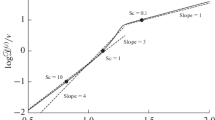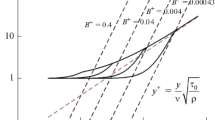Abstract
The eddy viscosity and the eddy diffusivity are calculated for the viscous sublayer in turbulent flow near a solid surface by using Fourier transforms of a spectral element of the velocity profiles, the pressure, and the concentration. The different spectral elements are assumed to behave independently of each other in this region, and the magnitudes are plotted as functions of distance from the wall. The tangential velocity profiles show a slope of unity on log–log plots against distance y from the wall, while the normal component shows a slope of 2. The concentration profiles generally show a slope of unity except near the outer limit of the viscous sublayer. There is also a dependence on the value of the Schmidt number as well as the concentration fluctuation assumed to prevail at a distance of δ0 at the outer limit of the viscous sublayer. When the normal velocity fluctuation is correlated with either the streamwise velocity fluctuation or with the concentration fluctuation, one infers a slope for the eddy viscosity or the eddy diffusivity of 3. The eddy diffusivity shows more structure than the eddy viscosity and can differ substantially from the latter in the depths of the viscous sublayer.





Similar content being viewed by others
REFERENCES
Murphree, E.V., Relation between heat transfer and fluid friction, Ind. Eng. Chem., 1932, vol. 24, p. 726. https://doi.org/10.1021/ie50271a004
Levich, B., The theory of concentration polarization, I, Acta Physicochim. URSS, 1942, vol. 17, p. 257.
Levich, V.G., Physicochemical Hydronamics, Englewood Cliffs, NJ: Prentice-Hall, 1962.
Vorotyntsev, M.A., Martem’yanov, S.A., and Grafov, B.M., Closed equation of turbulent heat and mass transport, J. Exp. Theor. Phys., 1980, vol. 52, p. 909.
Martemianov, S.A., Statistical theory of turbulent mass transfer in electrochemical systems, Russ. J. Electrochem., 2017, vol. 53, p. 1076.
Newman, J. and Thomas-Alyea, K.E., Electrochemical Systems, Hoboken, NJ, John Wiley, 2004.
Newman, J., Theoretical analysis of turbulent mass transfer with rotating cylinders, J. Electrochem. Soc., 2016, vol. 163, p. E191.
Newman, J., Application of the dissipation theorem to turbulent flow and mass transfer in a pipe, Russ. J. Electrochem., 2017, vol. 53, p. 1061.
Newman, J., Eddy diffusivity in the viscous sublayer, Russ. J. Elecrochem., 2019, vol. 55, no. 10, p. 1031.
Newman, J., Further thoughts on turbulent flow in a pipe, Russ. J. Elecrochem., 2019, vol. 55, p. 34. https://doi.org/10.1134/S1023193519010105
Martem’yanov, S.A., Vorotyntsev, M.A., and Grafov, B.M., Derivation of the nonlocal transport equation of matter in the turbulent diffusion layer, Sov. Electrochem., 1979, vol. 15, no. 6, p. 787.
Martem’yanov, S.A., Vorotyntsev, M.A., and Grafov, B.M., Functional form of the turbulent diffusion coefficient in the layer next to the electrode, Sov. Electrochem., 1979, vol. 15, no. 6, p. 780.
Martem’yanov, S.A., Vorotyntsev, M.A., and Grafov, B.M., Turbulent heat and mass transfer near flat surfaces at moderate and small Prandtl–Schmidt numbers, Sov. Electrochem., 1980, vol. 16, no. 7, p. 783.
Author information
Authors and Affiliations
Corresponding author
Ethics declarations
The author declares that he has no conflict of interest.
TURBULENT FLOW IN A PIPE
TURBULENT FLOW IN A PIPE
One might be able to approach a valid treatment of fully developed turbulence in a pipe. The steady, fully developed flow has only an axial velocity component, and this depends only on radial position. The average axial pressure drop is the same at each axial and radial position, although there may be a radial average pressure variation as discussed below.
Thus one could express the fluctuations as a sum of a finite number of spectral components of a form similar to that used in the present linear problem:
The problem is reduced to finding the radial dependence of Vr, Vθ, Vz, and P for these spectral components. This is a formidable problem, but still simpler than solving directly for fluctuating components in time and space. This method of treating interacting Fourier components could also be used in the present problem for extending the valid range farther into the outer turbulent flow for a single spectral component.
Is there a variation of average pressure with radial position in this pipe flow? I thought I found one in about 1963, but I have lost any notes on it. The averaged radial component of the equation of motion is
Even if the third term on the left is zero, the fourth term would be expected to generate a nonzero contribution. The first term will generate a zero result overall, since it can be integrated and the correlation should be zero at both the center and the pipe wall. The second term should be zero since the angular fluctuation should not be correlated with the radial fluctuation (fluctuations of the angular velocity should be equally probable in the plus and minus θ directions).
Rights and permissions
About this article
Cite this article
John Newman Viscous Sublayer. Russ J Electrochem 56, 263–269 (2020). https://doi.org/10.1134/S102319352003009X
Received:
Revised:
Accepted:
Published:
Issue Date:
DOI: https://doi.org/10.1134/S102319352003009X




